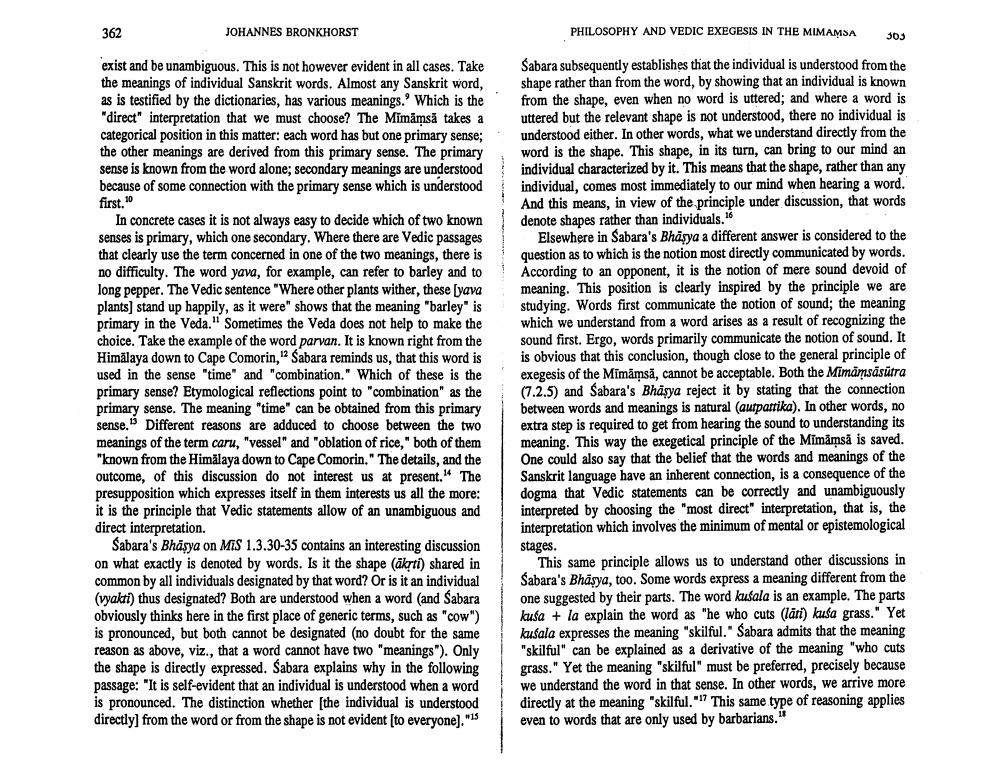Book Title: Philosophy And Vedic Exegesis In Mimamsa Author(s): Johannes Bronkhorst Publisher: Johannes Bronkhorst View full book textPage 3
________________ 362 JOHANNES BRONKHORST PHILOSOPHY AND VEDIC EXEGESIS IN THE MIMAMSA 303 exist and be unambiguous. This is not however evident in all cases. Take the meanings of individual Sanskrit words. Almost any Sanskrit word, as is testified by the dictionaries, has various meanings. Which is the "direct" interpretation that we must choose? The Mimamsă takes a categorical position in this matter: each word has but one primary sense; the other meanings are derived from this primary sense. The primary sense is known from the word alone, secondary meanings are understood because of some connection with the primary sense which is understood first. In concrete cases it is not always easy to decide which of two known senses is primary, which one secondary. Where there are Vedic passages that clearly use the term concerned in one of the two meanings, there is no difficulty. The word yava, for example, can refer to barley and to long pepper. The Vedic sentence "Where other plants wither, these [yava plants) stand up happily, as it were" shows that the meaning "barley" is primary in the Veda." Sometimes the Veda does not help to make the choice. Take the example of the word parvan. It is known right from the Himalaya down to Cape Comorin," Sabara reminds us, that this word is used in the sense "time" and "combination." Which of these is the primary sense? Etymological reflections point to "combination" as the primary sense. The meaning "time" can be obtained from this primary sense.” Different reasons are adduced to choose between the two meanings of the term caru, "vessel" and "oblation of rice," both of them "known from the Himālaya down to Cape Comorin." The details, and the outcome, of this discussion do not interest us at present." The presupposition which expresses itself in them interests us all the more: it is the principle that Vedic statements allow of an unambiguous and direct interpretation. Sabara's Bhäsya on Mis 1.3.30-35 contains an interesting discussion on what exactly is denoted by words. Is it the shape (akyti) shared in common by all individuals designated by that word? Or is it an individual (vyakti) thus designated? Both are understood when a word (and Sabara obviously thinks here in the first place of generic terms, such as "cow") is pronounced, but both cannot be designated (no doubt for the same reason as above, viz., that a word cannot have two "meanings"). Only the shape is directly expressed. Sabara explains why in the following passage: "It is self-evident that an individual is understood when a word is pronounced. The distinction whether (the individual is understood directly from the word or from the shape is not evident (to everyone)."" Sabara subsequently establishes that the individual is understood from the shape rather than from the word, by showing that an individual is known from the shape, even when no word is uttered; and where a word is uttered but the relevant shape is not understood, there no individual is understood either. In other words, what we understand directly from the word is the shape. This shape, in its turn, can bring to our mind an individual characterized by it. This means that the shape, rather than any individual, comes most immediately to our mind when hearing a word. And this means, in view of the principle under discussion, that words denote shapes rather than individuals. Elsewhere in Sabara's Bhäşya a different answer is considered to the question as to which is the notion most directly communicated by words. According to an opponent, it is the notion of mere sound devoid of meaning. This position is clearly inspired by the principle we are studying. Words first communicate the notion of sound; the meaning which we understand from a word arises as a result of recognizing the sound first. Ergo, words primarily communicate the notion of sound. It is obvious that this conclusion, though close to the general principle of exegesis of the Mimāmsă, cannot be acceptable. Both the Mimāmsāsūtra (7.2.5) and Sabara's Bhäsya reject it by stating that the connection between words and meanings is natural (autpartika). In other words, no extra step is required to get from hearing the sound to understanding its meaning. This way the exegetical principle of the Mimamsă is saved. One could also say that the belief that the words and meanings of the Sanskrit language have an inherent connection, is a consequence of the dogma that Vedic statements can be correctly and unambiguously interpreted by choosing the "most direct" interpretation, that is, the interpretation which involves the minimum of mental or epistemological stages. This same principle allows us to understand other discussions in Sabara's Bhäsya, too. Some words express a meaning different from the one suggested by their parts. The word kusala is an example. The parts kusa + la explain the word as "he who cuts (lāti) kusa grass." Yet kusala expresses the meaning "skilful." Sabara admits that the meaning "skilful" can be explained as a derivative of the meaning "who cuts grass." Yet the meaning "skilful" must be preferred, precisely because we understand the word in that sense. In other words, we arrive more directly at the meaning "skilful." This same type of reasoning applies even to words that are only used by barbarians."Page Navigation
1 2 3 4 5 6 7
